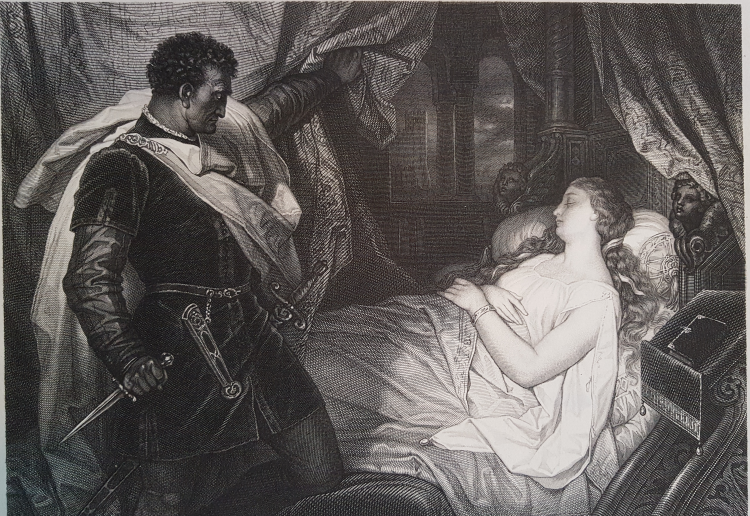
E. Buchel’s atmospheric ‘Othello’ engraving captures the suspenseful ending of William Shakespeare’s romantic tragedy. The artist’s use of chiaroscuro powerfully illustrates Act V Sc ii’s symbolic language, “put out the light, and then put out the light”. Whilst the luxurious mass of drapery envelopes and shrouds Desdemona in darkness, she herself remains a glowing figure, whose skin is ‘whiter’ than ‘snow and ‘smooth as monumental alabaster’. The composition illustrates the couple’s contrasted power roles, as Othello dominantly leans his knee on the padded foot-stall, tightly gripping his dagger, whereas Desdemona lay peaceful, reclining onto the bed with her arms about her waist. Sleeping, she is fully unaware of the suspense rising in front of her. Othello stares straight at his wife full of fake jealousy and betrayal – if you look close enough, you can see the vein bursting on his temple. The artist has captured an expression on Othello’s face which depicts the famous line: “Yet she must die, else she’ll betray more men”. When you look at the shapes and lines in the illustration, you see that all the drapery and clothing is restricted in torsion, the fabric is crumpled and distorted, which portrays the tensions and suspense of the characters. Behind the drapes is a window which reveals the moonlight shining through the clouds. This night sky image further emphasises the disconcerting tone of the final scene, and further illustrates key dialogue in the play:
“it is the very error of the moon;
she comes near the earth than she was wont
and makes men mad”
Othello blames the full moon and its closeness to the earth for the murders that take place, giving it a bad omen. There is a hint of irony in Othello’s dialogue: Shakespeare parallels Desdemona and the moon for both coming to ‘close’ to men and seducing them with their beautiful whiteness.
I love this Victorian illustration for the way the detail depicts a foreboding atmosphere. I think the 19th century artistic mind has casted its Gothic shadow over the Renaissance tragedy whilst illuminating the memorable jewels of Shakespeare’s language.